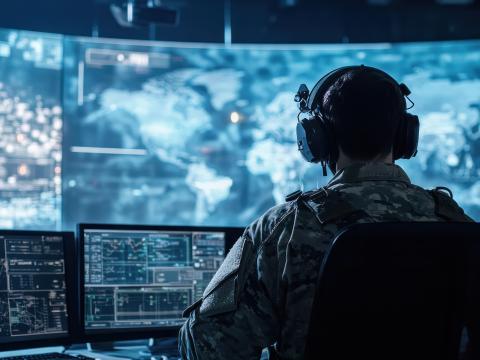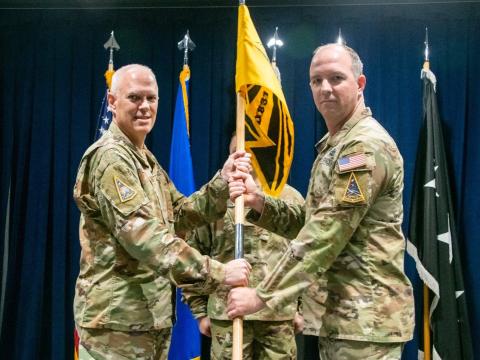The Close, Brutal Nature of Potential Combat in the Indo-Pacific Has Army Pacific on Its Toes
Gen. Ronald Clark, USA, commanding general, U.S. Army Pacific (USARPAC), is considering the complexity of operating in the Indo-Pacific region.
He sees the need for a comprehensive approach to address the unique challenges of the region, and is committed to finding solutions for the major command.
The tyranny of distance in the Indo-Pacific region is great. The Indo-Pacific is home to the world’s five largest militaries. The region encompasses 60% of the world’s population, with 36 countries and 16 time zones, ranging from the Arctic to the Antarctic, “from Hollywood to Bollywood, and from polar bears to penguins and everywhere in between,” as the saying goes at USARPAC, the general said.
The square footage of Western Europe alone could fit into just the South China Sea.
Not to mention the dense jungles, remote coral atolls and high mountains, all of which would require careful warfighting. Clark has to make sure that the U.S. soldiers in the Indo-Pacific “are as lethal, resilient and ready for the close, personal, brutal nature of combat” that this region requires.
“The Indo-Pacific represents a unique and complex set of challenges,” Clark stated. “The operational realities of maintaining readiness, projecting power, fighting forward on and from the land, while sustaining the joint force across vast distances, is the reality of this theater.”
And in such a menacingly vast region, the biggest dangers are passivity, failure or error, the commanding general continued.
“In my opinion, the greatest risk that we face day-to-day in this region is the risk that in this tech-enabled, data-centric, lethal environment that requires us to have positional advantage in competition, crisis and conflict, the greatest risk is risk to inaction,” the commanding general emphasized. “That is the risk of being late to understand, late to need, out of position, just plain not doing enough, fast enough, or even worse, doing nothing at all.”
The key, Clark said, is for USARPAC to adapt and innovate. Innovation and training are necessary to solve the problems that the military faces in the region. The Army, especially, must be able to project agile land power, command and maneuver across dispersed positions. As such, he cites his top two priorities as people—and their persistent presence forward in the region—and partnerships.
“In a world where technology advances at a breathtaking pace, it is imperative that we not only encourage but embrace innovation," he noted.
Making strides, USARPAC continues to improve interoperability—human, procedural and technical—across the joint force and partners. The United States’ relationships with Indo-Pacific nations, allies and partners are what will be our asymmetric advantage against near-peer adversaries in the region, the commanding general emphasized, speaking to the importance of partnerships.
“To address this tyranny of distance and to overcome the challenges posed by near-peer adversaries, we innovate and we train,” Clark stated. “We innovate and we train for the problems we know we have to solve, and we do this while balancing and mitigating risk.”
The U.S. military trains together in 39 separate exercises with 53 partner nations each year, raising the bar together. The United States must not outpace our allies; the nation must modernize together with its partners, the commanding general said.
He sees USARPAC as the Army’s test bed in the U.S. military’s priority region, with the 25th Infantry Division (25th ID) as front and center to these activities.
USARPAC is currently preparing for Joint Pacific Multinational Readiness Center rotations (JPMRC). In addition to JPMRC rotations on Oahu and on the island of Hawaii, USARPAC also conducts movements in Alaska, the Pacific Northwest, and in allied countries across the region, he said.
In advance of the next JPMRC rotation, 25th ID is testing 16 new formations and conducting 39 tactical environment experiments over the next two weeks at Schofield Barracks.
“Here in Hawaii, our 25th Infantry Division, Tropic Lightning, is one of the Army’s first two divisions to transform in contact,” he shared. “They are testing new capabilities to make our soldiers more lethal, survivable and adaptable . . . Combat is, has been and always will be, a violent human endeavor. Therefore, we must ensure that our soldiers and our forces and our formations have the ability to see first sense, first strike, first and protect always.”
As it embraces a culture of innovation and experimentation, USARPAC has conducted multiple signature events focused on solving complex challenges in the Indo-Pacific, not just with the greater Army, but also with the joint force.
USARPAC hosted the latest event for the groundbreaking Project Convergence in the theater, which involved multiple combatant commands, and “great participation” from the joint force and multinational allies and partners, “more than we've ever seen before,” the general ventured.
Our third priority, and one we cannot miss, is to prevail. We have no choice. The cost of failure is just too high.
The organization was also involved in U.S. Indo-Pacific Commander Adm. Samuel Paparo’s recent Artificial Intelligence Summit, which brought together the region’s component commanders and leaders from the technology industry.
In addition, a month and a half ago, the secretary of the Army and the chief of staff of the Army hosted an artificial intelligence tabletop exercise with USARPAC at the Pentagon, also leveraging industry and technology CEOs from across the country. The exercise focused on the Army’s unique challenges in the Indo-Pacific, Clark shared.
“The task to innovate is daunting for the Army, who, if you weren’t sure, is large,” Clark continued. “In fact, the Army is the third largest company in the United States of America, behind only Amazon and Walmart.”
The commanding general will also continue to emphasize his third priority: to prevail against adversaries.
“Our third priority, and one we cannot miss, is to prevail,” he stressed. “We have no choice. The cost of failure is just too high.”
Clark took command last November of USARPAC, which is the Army’s largest Service Component Command. It is located at Fort Shafter, Hawaii, with portions of the command forward-deployed throughout the Indo-Pacific.
The commanding general spoke Tuesday at AFCEA’s 40th annual TechNet Indo-Pacific conference held October 28-30, in Honolulu.
“Your continued pursuit of cutting-edge solutions to address our challenges cannot be understated,” Clark told the crowd.
TechNet Indo-Pacific is organized by AFCEA International and AFCEA Hawaii. SIGNAL Media is the official media of AFCEA International.




Comments